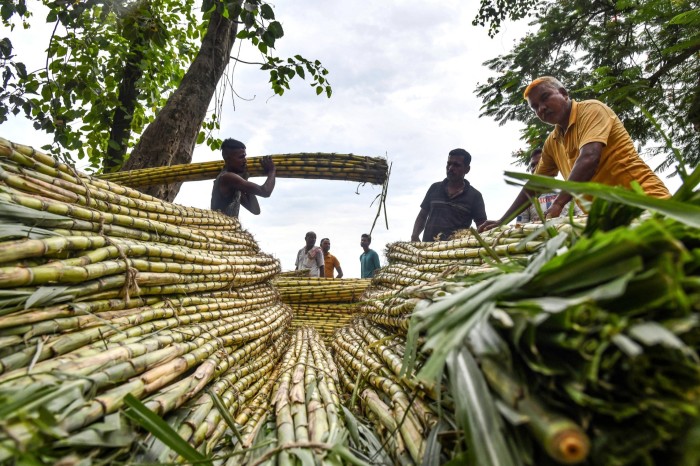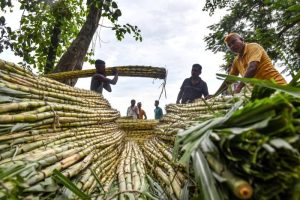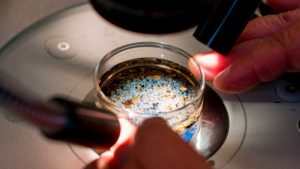Bioplastics start-ups gain ground but green credentials face scrutiny

If it is difficult to fathom the sheer volume of plastic production in the world today, the scale of associated waste and pollution is perhaps still harder to grasp.
More than three-quarters of the 460mn tonnes of plastic produced in 2019 became waste, OECD figures show — much of it in landfill, but also destined for incineration and leakage into rivers and oceans. And, with their heavy reliance on fossil fuels for raw materials, plastics account for about 3.4 per cent of global greenhouse gas emissions — more than the aviation industry.
Yet, even as evidence mounts of the harm caused by discarded plastics — whether in the form of microplastics accumulating in the human body, or consumer waste choking ocean wildlife — so does demand. OECD projections indicate production will reach 1.2bn tonnes by 2060, with 1bn tonnes of waste.
Can demand be met without the downsides? A wave of innovators argue that it can, provided the industry shifts away from fossil fuel-based feedstocks towards biological alternatives. Derived from organic, renewable sources — such as corn, seaweed, or sugarcane — so-called bioplastics have, their proponents say, a smaller carbon footprint and can be engineered to biodegrade, further curbing plastic pollution.
Start-ups are experimenting with different materials and focusing on different product areas. Australia-based BioPak, for example, uses sugarcane waste to make takeaway packaging that is home-compostable. Loliware in the US makes drinking straws from biodegradable seaweed, and raised $6mn last year. UK-based Sparxell, which raised $3.2mn in April, specialises in plant-based pigments, an alternative to the toxic additives used to colour plastic.

Overall production of bioplastics is increasing, although it is still a tiny fraction of the whole plastics market. Statista, a data provider, predicts that output of bioplastics will increase from 2.2mn tonnes in 2022 to 7.4mn tonnes by 2028, while research company Precedence expects the market’s value to rise more than fivefold, to $105bn, a decade from now.
Policymakers are encouraging this growth. Last year, US President Joe Biden’s administration, following up on a 2022 executive order to advance biotechnology and biomanufacturing, proposed a goal of replacing 90 per cent of conventional plastics in the US with bio-based alternatives within the next 20 years.
The EU is more cautious, but its policy framework for bioplastics, also launched in 2022, notes that they “can bring advantages over conventional ones if designed for circularity, produced safely and from sustainably sourced feedstock”.
Those caveats are important, because even bioplastics are not necessarily planet-friendly. Many “compostable” bioplastics require industrial composting facilities, to which consumers often lack ready access.
In addition, many bioplastics — despite their organic origin — are chemically identical to fossil fuel-based versions, or contain toxic additives, or break down into the same polluting microplastics. A 2020 study, published in the journal Environment International, concluded that “bio-based/biodegradable materials and conventional plastics are similarly toxic” — one reason that some commercial facilities will refuse to accept even supposedly compostable varieties.
Jonatan Kleimark, senior chemicals adviser at ChemSec, a Swedish non-profit focused on reducing the use of hazardous chemicals, says part of the problem is that the terms “bioplastic”, “biomaterial” and “bio-based” are wide-ranging. With the industry still operating in what Kleimark calls a “regulation vacuum”, this enables companies to make baseless or overinflated claims.
“Beneath the umbrella concept, we lack definitions and that opens up for making it look greener than it is,” he explains. “From a chemicals perspective, the main issue is not whether they are fossil fuel-based or bio-based, but whether we add toxic chemicals to them — which, today, we have to do to most polymers to attain the desired performance and functionality.”
Sian Sutherland, co-founder of campaign groups A Plastic Planet and PlasticFree, argues that the industry needs to “leapfrog” over biomaterials that are “less bad” than conventional plastic to “materials that are truly good for nature”. Since ambitions for an “amazing worldwide industrial composting infrastructure” have not been realised, she argues that “the mindset needs to shift to materials that can go back to nature safely”.

Shellworks, a UK-based start-up, is pursuing that aim. It has developed a material called Vivomer, which is derived from microbes found in the soil or sea and can be formed into solid containers. Once returned to the soil or sea, the same microbes will recognise it as food and break it down, without producing microplastics in the process.
“We are a bit purist and uncompromising,” says co-founder Insiya Jafferjee. “We have two rules: everything we use has to be renewable and everything we add has to degrade in a home-compostable environment.”
At the moment, however, Shellworks is the exception rather than the rule, says Jafferjee. She admits that her business “and the other companies that consider ourselves uncompromising meet quite often and we can count the whole network on our hands”.
Larger competitors, she says, were “born in an earlier industry [so] had to compromise to survive”. She cites the use of PLA, a bio-based polyester that does not readily biodegrade, and of oxo-degradables (plastics with additives to accelerate disintegration), “which is even worse, because it actually creates more microplastics”.

Other innovators — such as California-based Sway which, this year, raised $5mn to scale its packaging business — say seaweed trumps other natural materials.
Unlike corn or sugarcane, seaweed regenerates rapidly, does not take up prime agricultural (or even once forested) land, requires no chemical inputs, and replenishes marine ecosystems. Sway’s product is home-compostable, and the start-up is aiming to grow through partnerships with brands such as US apparel company J Crew.
However, bioplastics account for a meagre 1 per cent of total plastic production, according to US pressure group Beyond Plastics — a figure that has remained static over the past few years. In that time, conventional plastics have continued to benefit from government subsidies — both directly in grants for manufacturing plants and indirectly through subsidising oil and gas — and from the cheapness and availability of fossil-fuel feedstocks compared with bio-based alternatives.
“It’s always going to be about money and, right now, because plastic is so heavily subsidised, no other material can compete,” says Sutherland. “If your driving force within industry is your bottom line, and how cheaply you can make a product, then plastics are always going to win.”
Kleimark argues that regulation is needed to spur companies to move to biomaterials and to clamp down on conventional plastic production. “Today, tens of thousands of plastic polymers are used,” he says. “If we reduced the amount of plastic types, there would be a more obvious market for bio-based materials.”
Any shortened list of approved plastics would certainly include bioplastics, he explains, whose advantages — in terms of recyclability or biodegradability, say — would be more apparent with fewer alternatives to choose from. Their benefits would be clearer still, he says, if regulators could ensure that the price of plastics includes external costs, such as chemical pollution and waste.
Regulation could also prevent companies from making misleading claims about the eco-credentials of their bioplastics by setting stringent standards about biodegradability and other properties. The UN’s global treaty, which aims to regulate plastic production and is under negotiation, will include a framework to define bioplastics.
“We have a tremendous opportunity to reframe what is an alternative to plastic,” says Sutherland, who is involved with the treaty talks, which bring activists and industry figures together to shape the final agreement. “And the solutions, against all the odds, are achieving incredible things. There are fantastic companies that are building the material future, and that future is available today.”
#Bioplastics #startups #gain #ground #green #credentials #face #scrutiny





